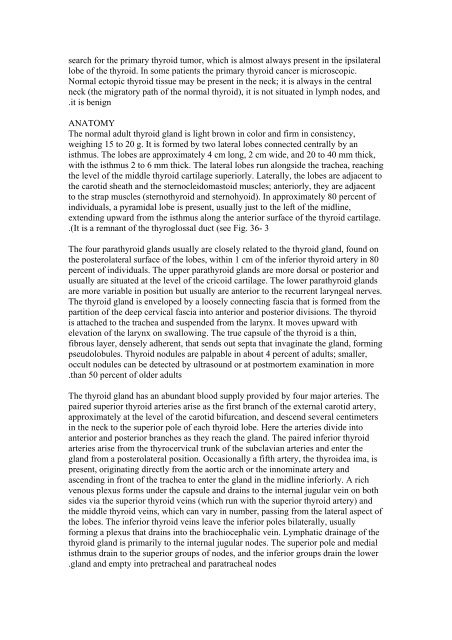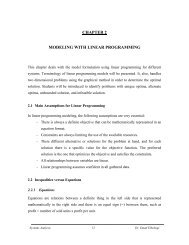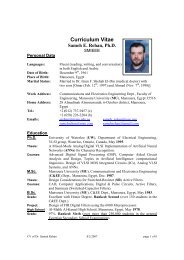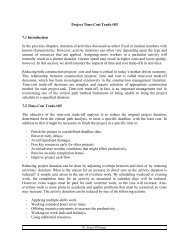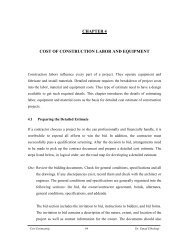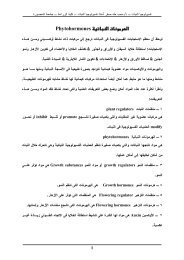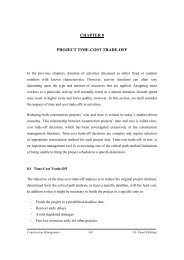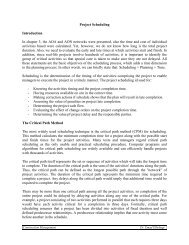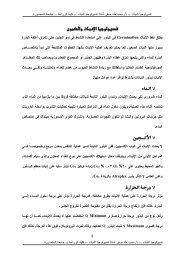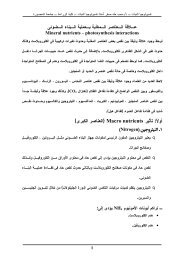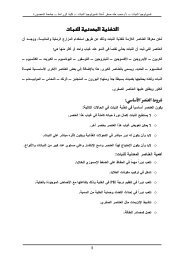Thyroid and Parathyroid
Thyroid and Parathyroid
Thyroid and Parathyroid
You also want an ePaper? Increase the reach of your titles
YUMPU automatically turns print PDFs into web optimized ePapers that Google loves.
search for the primary thyroid tumor, which is almost always present in the ipsilateral<br />
lobe of the thyroid. In some patients the primary thyroid cancer is microscopic.<br />
Normal ectopic thyroid tissue may be present in the neck; it is always in the central<br />
neck (the migratory path of the normal thyroid), it is not situated in lymph nodes, <strong>and</strong><br />
. it is benign<br />
ANATOMY<br />
The normal adult thyroid gl<strong>and</strong> is light brown in color <strong>and</strong> firm in consistency,<br />
weighing 15 to 20 g. It is formed by two lateral lobes connected centrally by an<br />
isthmus. The lobes are approximately 4 cm long, 2 cm wide, <strong>and</strong> 20 to 40 mm thick,<br />
with the isthmus 2 to 6 mm thick. The lateral lobes run alongside the trachea, reaching<br />
the level of the middle thyroid cartilage superiorly. Laterally, the lobes are adjacent to<br />
the carotid sheath <strong>and</strong> the sternocleidomastoid muscles; anteriorly, they are adjacent<br />
to the strap muscles (sternothyroid <strong>and</strong> sternohyoid). In approximately 80 percent of<br />
individuals, a pyramidal lobe is present, usually just to the left of the midline,<br />
extending upward from the isthmus along the anterior surface of the thyroid cartilage.<br />
.( It is a remnant of the thyroglossal duct (see Fig. 36- 3<br />
The four parathyroid gl<strong>and</strong>s usually are closely related to the thyroid gl<strong>and</strong>, found on<br />
the posterolateral surface of the lobes, within 1 cm of the inferior thyroid artery in 80<br />
percent of individuals. The upper parathyroid gl<strong>and</strong>s are more dorsal or posterior <strong>and</strong><br />
usually are situated at the level of the cricoid cartilage. The lower parathyroid gl<strong>and</strong>s<br />
are more variable in position but usually are anterior to the recurrent laryngeal nerves.<br />
The thyroid gl<strong>and</strong> is enveloped by a loosely connecting fascia that is formed from the<br />
partition of the deep cervical fascia into anterior <strong>and</strong> posterior divisions. The thyroid<br />
is attached to the trachea <strong>and</strong> suspended from the larynx. It moves upward with<br />
elevation of the larynx on swallowing. The true capsule of the thyroid is a thin,<br />
fibrous layer, densely adherent, that sends out septa that invaginate the gl<strong>and</strong>, forming<br />
pseudolobules. <strong>Thyroid</strong> nodules are palpable in about 4 percent of adults; smaller,<br />
occult nodules can be detected by ultrasound or at postmortem examination in more<br />
. than 50 percent of older adults<br />
The thyroid gl<strong>and</strong> has an abundant blood supply provided by four major arteries. The<br />
paired superior thyroid arteries arise as the first branch of the external carotid artery,<br />
approximately at the level of the carotid bifurcation, <strong>and</strong> descend several centimeters<br />
in the neck to the superior pole of each thyroid lobe. Here the arteries divide into<br />
anterior <strong>and</strong> posterior branches as they reach the gl<strong>and</strong>. The paired inferior thyroid<br />
arteries arise from the thyrocervical trunk of the subclavian arteries <strong>and</strong> enter the<br />
gl<strong>and</strong> from a posterolateral position. Occasionally a fifth artery, the thyroidea ima, is<br />
present, originating directly from the aortic arch or the innominate artery <strong>and</strong><br />
ascending in front of the trachea to enter the gl<strong>and</strong> in the midline inferiorly. A rich<br />
venous plexus forms under the capsule <strong>and</strong> drains to the internal jugular vein on both<br />
sides via the superior thyroid veins (which run with the superior thyroid artery) <strong>and</strong><br />
the middle thyroid veins, which can vary in number, passing from the lateral aspect of<br />
the lobes. The inferior thyroid veins leave the inferior poles bilaterally, usually<br />
forming a plexus that drains into the brachiocephalic vein. Lymphatic drainage of the<br />
thyroid gl<strong>and</strong> is primarily to the internal jugular nodes. The superior pole <strong>and</strong> medial<br />
isthmus drain to the superior groups of nodes, <strong>and</strong> the inferior groups drain the lower<br />
.<br />
gl<strong>and</strong> <strong>and</strong> empty into pretracheal <strong>and</strong> paratracheal nodes


